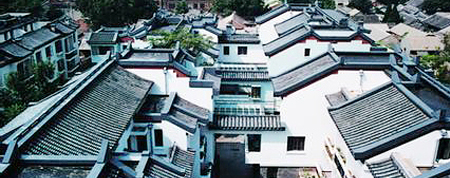Beijing courtyard houses: old homes, new vigor

Juer Hutong (Chrysanthemum Lane,) located in inner Beijing’s Dongcheng District, takes on a new look after undergoing a project of renovation in the 1990s.
Consisting of a courtyard surrounded by buildings on all four sides, classical courtyard houses, known in Mandarin as siheyuan, are a historical type of residence commonly found in China, most famously in Beijing. Today, many remaining siheyuan are still used as housing complexes but lack modern amenities. Serving as the cultural symbol of Beijing, they exhibit outstanding and fundamental characteristics of Chinese architecture. As old urban buildings continue to be demolished in modern Beijing to create space for rapid economic development and a growing population, the preservation of siheyuan is becoming a major topic for debate.
Juer hutong renovated
The Juer Hutong, or “Chrysanthemum Lane,” located in inner Beijing’s Dongcheng District and stretching westward to the scenic spot and commercial lane Nanluoguxiang, was once a typical decaying and dilapidated traditional courtyard house neighborhood that urgently needed remodeling.
After a decade of research and design led by the famous Chinese architect Wu Liangyong starting in 1990, it was restored and renewed with a flexible courtyard system that achieves a balance between the historic residence scale and modern household style. The infrastructure and physical living space have been largely expanded and improved by the addition of three-story walk-up apartments grouped along the horizontal and vertical circulation lines, with a row of courtyards developed, forming a basic residential block to satisfy the demands of multi-household residence.
Walking in the Juer Hutong, visitors can appreciate the revitalized courtyard compound, which features a ground courtyard wall painted traditional gray while the two-and-three-story buildings are furnished with white walls and black-tiled roofs. It brings a green, quiet environment and at the same time, retains a socially cohesive community life.
First museum of hutong culture
The local community of Shijia Hutong has also found a way to preserve its slice of old Beijing culture. The Shijia Hutong Museum, located at the courtyard No. 24 of Shijia Hutong, Dongcheng District, is the first museum themed on one specific Hutong.
The former residence of Ling Shuhua, a writer who lived in the period of Republic of China, the courtyard had once been left unused. The restoration of the courtyard incorporated as much as possible the high technology that maintains the former structure of the courtyard while creating modern elements by adding eight exhibition rooms and one multifunctional hall. The exhibition rooms show the history, culture and change of Shijia Hutong, as well as the everyday life of the local residents. In the multifunctional hall, cultural salons, special exhibitions and lectures are usually held.
Visitors can see some antique objects once used in daily life that are now on the brink of disappearance, view a documentary that depicts the history of local residential life of the last century and hear some of the past sounds that are the epitome of old Beijing.
